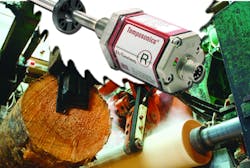Linear-Position Sensors increase performance for Wood Industry Applications
The improved construction increases the previously high performance and robustness standards of MTS' linear-position sensors, doubling the vibration force they can withstand. These developments, in addition to the rugged durability of their non-contact magnetostrictive technology, make MTS' Temposonics linear-position sensors ideal for wood industry applications including tree harvesting, router control, portable sawmills, log optimizer positioning, plywood press stroke, and paper and film slitters.
"MTS' Temposonics sensors have been providing accurate, high-speed performance for hydraulic positioning feedback control in harsh-environment wood industry applications for more than 30 years," said Matt Hankinson, Temposonics marketing manager. "Based on our experience in this industry, we made recent changes to the design and assembly of the R- and G-Series sensors to improve vibration resistance and longevity, ensuring that our sensors will continue to provide higher performance machining for increased productivity and reduced waste."
MTS' Temposonics linear-position sensors employ non-contact, magnetostrictive sensing technology, which, by eliminating wear, provide users with much higher durability and output reliability than the more fragile and environmentally vulnerable encoders that are standard on many other sensors. Inherently more robust than other sensing technologies, MTS' magnetostrictive sensors provide even higher performance and greater robustness than other magnetostrictive sensors, in part because MTS is the only magnetostrictive sensor supplier that manufactures its own waveguide. In doing so, MTS can carefully control its composition and quality in order
to maximize the sensors' linearity and signal-to-noise ratio to achieve a higher quality signal and provide consistently reliable, maximized performance.
The design changes made to MTS' Temposonics R- and G-Series linear-position sensors increase the longevity of the sensors' High Vibration Resistance (HVR) option, which doubles the prior vibration resistance of 15g. The improved linear-position sensors can survive impact forces of 100g and vibration forces of up to 30g (from 10-2000 Hz), which significantly increases their longevity, especially in harsh environments and high-vibration applications.
MTS' R-Series sensors are rugged, industrial sensors that provide absolute, linear position measurement with high-performance output protocols including SSI, DeviceNet, Profibus DP, and EtherCAT. With linearity down to +/- 20
microns or better, resolution of 1 micron, and repeatability within 0.001%, these sensors are ideal for applications that require accuracy, reliability, and consistency.
G-Series sensors are rugged, industrial sensors that provide highly accurate measurements in either analog or digital outputs, offer enhanced diagnostics and programming capabilities, and are designed for backwards compatibility with legacy Temposonics products.
Both series are easy to install and are preset with individual parameters according to order specifications to avoid time-consuming on-site calibration.
For more information on Temposonics linear-position sensors, visit their web site
at http://www.mtssensors.com.

